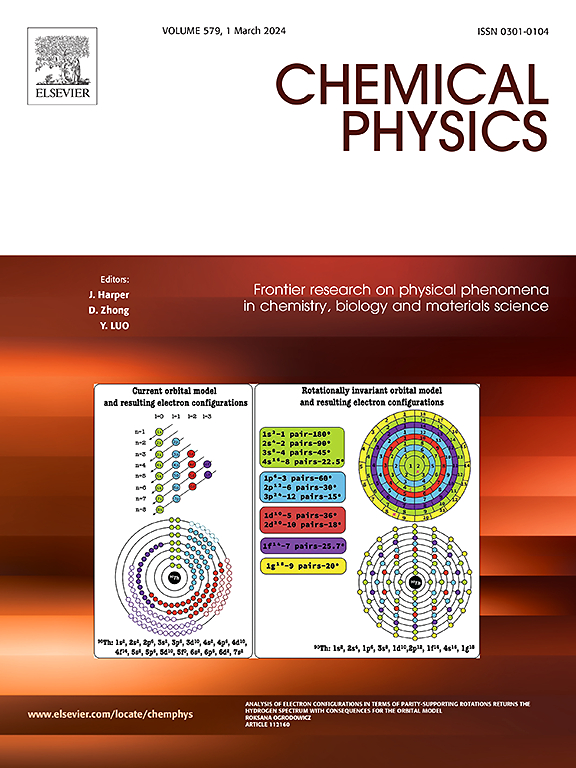RbNbX₃(X = cl, Br, I)无铅卤化物钙钛矿:用于能源应用的结构、弹性、电子和热电性质的DFT研究
IF 2.4
3区 化学
Q4 CHEMISTRY, PHYSICAL
引用次数: 0
摘要
寻找稳定的无铅钙钛矿作为解决铅基钙钛矿的毒性和不稳定性挑战的一种有希望的解决方案,受到了广泛的关注。该研究使用密度泛函理论框架内的第一性原理计算全面研究了铷基立方卤化物钙钛矿RbNbX₃(X = Cl, Br, I)。通过在WIEN2k中实现的全势线性化增强平面波(FP-LAPW)方法,我们系统地分析了材料的结构、弹性、力学、电子、磁性和热电性能。通过Birch-Murnaghan状态方程进行结构优化,确定了晶格参数为5.2049 Å, 5的立方对称性。RbNbX3 (X = Cl, Br, I)分别为4918 Å和5.8665 Å,显示出稳定的铁磁基态。利用改进的Becke-Johnson (mBJ)势进行的电子结构计算表明,间接带隙为1.023 eV (Cl)、0.866 eV (Br)和0.710 eV (I),总磁矩为~ 3 μB,主要来自Nb-4d轨道。通过计算态密度来预测化合物中不同原子轨道的相互作用。通过弹性常数分析确认了机械稳定性,RbNbCl₃和RbNbBr₃表现出脆性特征,而RbNbI₃根据Pugh’s ratio评估表现出延展性行为。热电分析证实,RbNbX₃钙钛矿在能量转换应用中表现出极好的潜力,表明RbNbI₃的峰值ZT值为0.99 (100K), RbNbBr₃的峰值ZT值为0.86 (500 K), RbNbCl₃的峰值ZT值为0.8 (900 K)。优异的性能来源于优异的塞贝克系数(高达2917 μV/K)和低导热系数。所有这些发现都表明RbNbX₃钙钛矿是自旋电子和其他先进能源技术的有希望的候选者,所有这些都在环境友好的框架内。本文章由计算机程序翻译,如有差异,请以英文原文为准。
RbNbX₃ (X = cl, Br, I) lead-free halide perovskites: A DFT study of structural, elastic, electronic, and thermoelectric properties for energy applications
The search for stable lead-free perovskites has gained significant attention as a promising solution to address the toxicity and instability challenges of lead-based counterparts. This investigation comprehensively examines rubidium-based cubic halide perovskites RbNbX₃ (X = Cl, Br, I) using first-principles calculations within the density functional theory framework. Through the full-potential linearized augmented-plane-wave (FP-LAPW) method implemented in WIEN2k, we systematically analyze the structural, elastic, mechanical, electronic, magnetic, and thermoelectric properties. Structural optimization via the Birch-Murnaghan equation of state confirms cubic symmetry with lattice parameters of 5.2049 Å, 5. 4918 Å and 5.8665 Å for RbNbX3 (X = Cl, Br, I), respectively, and reveals a stable ferromagnetic ground state. Electronic structure calculations using the modified Becke-Johnson (mBJ) potential demonstrate semiconducting behavior with indirect band gaps of 1.023 eV (Cl), 0.866 eV (Br), and 0.710 eV (I), accompanied by a consistent total magnetic moment of ∼3 μB predominantly originating from Nb-4d orbitals. Densities of states are calculated to predict the interaction of orbitals of distinct atoms in the compounds. Mechanical stability is confirmed through elastic constant analysis, with RbNbCl₃ and RbNbBr₃ exhibiting brittle characteristics while RbNbI₃ shows ductile behavior based on Pugh's ratio evaluation. Thermoelectric analysis confirms that RbNbX₃ perovskites exhibit excellent potential for energy conversion applications, demonstrating peak ZT values of 0.99 (100K) for RbNbI₃, 0.86 (500 K) for RbNbBr₃, and 0.8 (900 K) for RbNbCl₃. These high figures of merit arise from their superior Seebeck coefficients (up to 2917 μV/K) and low thermal conductivity. All these findings establish RbNbX₃ perovskites as promising candidates for spintronic and other advanced energy technologies, all within an environmentally friendly framework.
求助全文
通过发布文献求助,成功后即可免费获取论文全文。
去求助
来源期刊

Chemical Physics
化学-物理:原子、分子和化学物理
CiteScore
4.60
自引率
4.30%
发文量
278
审稿时长
39 days
期刊介绍:
Chemical Physics publishes experimental and theoretical papers on all aspects of chemical physics. In this journal, experiments are related to theory, and in turn theoretical papers are related to present or future experiments. Subjects covered include: spectroscopy and molecular structure, interacting systems, relaxation phenomena, biological systems, materials, fundamental problems in molecular reactivity, molecular quantum theory and statistical mechanics. Computational chemistry studies of routine character are not appropriate for this journal.
 求助内容:
求助内容: 应助结果提醒方式:
应助结果提醒方式:


